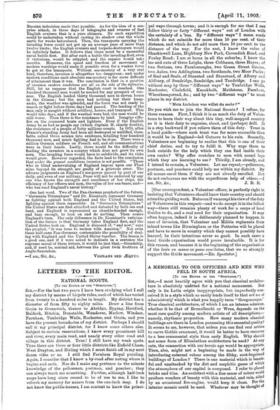A MEMORIAL TO OUR OFFICERS AND MEN WHO FELL IN
SOUTH AFRICA.
[To THE EDITOR OF TEE " SPECTATOR:] SIRT—I most heartily agree with you that classical architec- ture is absolutely unfitted for a national monument. Not only is its Latin origin inappropriate, but -imperfectly con- ceived it is a style which so easily lends itself to that art sec et administratif which is what you happily term " Gorgonesque:' True classical architecture, of which I am an intense admirer, whether it be that of Brunelleschi or Wren, depends on the most rare quality among modern artists of all descriptions,— namely, rhythmic proportion. How many modern classical buildings are there in London possessing this essential quality? It seems to me, however, that unless you can find real artists to carve Gothic ornament, it would be better to have recourse to a less ornamental style than early English. Why should not some form of Elizabethan architecture be used P At any rate, the connection with our heroic age would be :appropriate. Then, also, might not a beginning be made in the, way of introducing external colour among the filthy, sootebegrimed buildings of London ? There is one material which is beauti- fill and unattacked by the dirt and mephitic gases of which the atmosphere of our capital is composed. I refer to glazed bricks and tiles. An architect with a fine sense of colour could produce wonders of beauty with this material, and rain, aided by an occasional fire-engine, would keep it clean. For the the designs and their appropriateness, there is no denying that Sir William Richmond has recreated a technique of mosaic work of extraordinary perfection, which he has had carried out by English workmen. Surely this fine artistic achievement should be utilised. It is to be hoped that not merely lists of names will be found inside the building, but that symbolic sculpture will likewise play its part. Also there should be some general dedicatory inscription, as the Spectator once suggested, written in the languages used by those who fought,— English, French, and Dutch. The question arises, How is the right designer to be found ? Public competition has its disadvantages, but we should remember that by its means we got our finest monument. Without a competition, cer- tainly Stevens would never have been chosen for the work of designing a monument to the Duke of Wellington. It is, indeed, a source of relief to hear that the proposed memorial is to be a cloister of some sort, for this disposes of the nightmare suggestion of a dozen granite obelisks in Hyde Park. These "wild enormities of ancient magna- nimity" may be desirable in the sands of Egypt, but amidst English grass and trees, and by the dozen, the effect would be both hideous and absurd.—I am, Sir, &c.,
A READER.







































 Previous page
Previous page